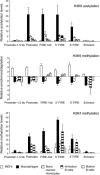Epigenetic silencing of the c-fms locus during B-lymphopoiesis occurs in discrete steps and is reversible
- PMID: 15483629
- PMCID: PMC524389
- DOI: 10.1038/sj.emboj.7600421
Epigenetic silencing of the c-fms locus during B-lymphopoiesis occurs in discrete steps and is reversible
Abstract
The murine c-fms (Csf1r) gene encodes the macrophage colony-stimulating factor receptor, which is essential for macrophage development. It is expressed at a low level in haematopoietic stem cells and is switched off in all non-macrophage cell types. To examine the role of chromatin structure in this process we studied epigenetic silencing of c-fms during B-lymphopoiesis. c-fms chromatin in stem cells and multipotent progenitors is in the active conformation and bound by transcription factors. A similar result was obtained with specified common myeloid and lymphoid progenitor cells. In developing B cells, c-fms chromatin is silenced in distinct steps, whereby first the binding of transcription factors and RNA expression is lost, followed by a loss of nuclease accessibility. Interestingly, regions of de novo DNA methylation in B cells overlap with an intronic antisense transcription unit that is differently regulated during lymphopoiesis. However, even at mature B cell stages, c-fms chromatin is still in a poised conformation and c-fms expression can be re-activated by conditional deletion of the transcription factor Pax5.
Figures








References
-
- Adolfsson J, Borge OJ, Bryder D, Theilgaard-Monch K, Astrand-Grundstrom I, Sitnicka E, Sasaki Y, Jacobsen SE (2001) Upregulation of Flt3 expression within the bone marrow Lin−Sca1+c-Kit+ stem cell compartment is accompanied by loss of self-renewal capacity. Immunity 15: 659–669 - PubMed
-
- Akashi K, Traver D, Miyamoto T, Weissman IL (2000) A clonogenic common myeloid progenitor that gives rise to all myeloid lineages. Nature 404: 193–197 - PubMed
-
- al-Bhadra M, Leibovitch BA, Gandhi SG, Rao M, Bhadra U, Birchler JA, Elgin SC (2004) Heterochromatic silencing and HP1 localization in Drosophila are dependent on the RNAi machinery. Science 303: 669–672 - PubMed
-
- Bird A (2002) DNA methylation patterns and epigenetic memory. Genes Dev 16: 6–21 - PubMed
Publication types
MeSH terms
Substances
LinkOut - more resources
Full Text Sources
Miscellaneous

